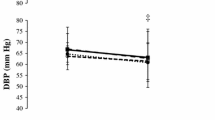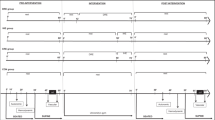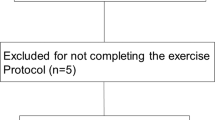Abstract
The occurrence of post-exercise hypotension after resistance exercise is controversial, and its mechanisms are unknown. To evaluate the effect of different resistance exercise intensities on post-exercise blood pressure (BP), and hemodynamic and autonomic mechanisms, 17 normotensives underwent three experimental sessions: control (C—40 min of rest), low- (E40%—40% of 1 repetition maximum, RM), and high-intensity (E80%—80% of 1 RM) resistance exercises. Before and after interventions, BP, heart rate (HR), and cardiac output (CO) were measured. Autonomic regulation was evaluated by normalized low- (LFR–Rnu) and high-frequency (HFR–Rnu) components of the R–R variability. In comparison with pre-exercise, systolic BP decreased similarly in the E40% and E80% (−6 ± 1 and −8 ± 1 mmHg, P < 0.05). Diastolic BP decreased in the E40%, increased in the C, and did not change in the E80%. CO decreased similarly in all the sessions (−0.4 ± 0.2 l/min, P < 0.05), while systemic vascular resistance (SVR) increased in the C, did not change in the E40%, and increased in the E80%. Stroke volume decreased, while HR increased after both exercises, and these changes were greater in the E80% (−11 ± 2 vs. −17 ± 2 ml/beat, and +17 ± 2 vs. +21 ± 2 bpm, P < 0.05). LFR–Rnu increased, while ln HFR–Rnu decreased in both exercise sessions. In conclusion: Low- and high-intensity resistance exercises cause systolic post-exercise hypotension; however, only low-intensity exercise decreases diastolic BP. BP fall is due to CO decrease that is not compensated by SVR increase. BP fall is accompanied by HR increase due to an increase in sympathetic modulation to the heart.


Similar content being viewed by others
References
American College of Sports Medicine (2000) ACSM’s guidelines for exercise testing and prescription. Lippincott Williams and Wilkins, Philadelphia
Bermudes AM, Vassallo DV, Vasquez EC, Lima EG (2004) Ambulatory blood pressure monitoring in normotensive individuals undergoing two single exercise sessions: resistive exercise training and aerobic exercise training. Arq Bras Cardiol 82:65–71, 57–64
Bisquolo VA, Cardoso CG Jr, Ortega KC, Gusmao JL, Tinucci T, Negrao CE, Wajchenberg BL, Mion D Jr, Forjaz CL (2005) Previous exercise attenuates muscle sympathetic activity and increases blood flow during acute euglycemic hyperinsulinemia. J Appl Physiol 98:866–871
Brown SP, Clemons JM, He Q, Liu S (1994) Effects of resistance exercise and cycling on recovery blood pressure. J Sports Sci 12:463–468
Bush JA, Kraemer WJ, Mastro AM, Triplett-McBride NT, Volek JS, Putukian M, Sebastianelli WJ, Knuttgen HG (1999) Exercise and recovery responses of adrenal medullary neurohormones to heavy resistance exercise. Med Sci Sports Exerc 31:554–559
Collins MA, Cureton KJ, Hill DW, Ray CA (1989) Relation of plasma volume change to intensity of weight lifting. Med Sci Sports Exerc 21:178–185
Convertino VA (1987) Fluid shifts and hydration state: effects of long-term exercise. Can J Sport Sci 12:136S–139S
DeVan AE, Anton MM, Cook JN, Neidre DB, Cortez-Cooper MY, Tanaka H (2005) Acute effects of resistance exercise on arterial compliance. J Appl Physiol 98:2287–2291
Fisher MM (2001) The effect of resistance exercise on recovery blood pressure in normotensive and borderline hypertensive women. J Strength Cond Res 15:210–216
Focht BC, Koltyn KF (1999) Influence of resistance exercise of different intensities on state anxiety and blood pressure. Med Sci Sports Exerc 31:456–463
Forjaz CL, Cardoso CG Jr, Rezk CC, Santaella DF, Tinucci T (2004) Postexercise hypotension and hemodynamics: the role of exercise intensity. J Sports Med Phys Fitness 44:54–62
Gotshall RW, Aten LA, Yumikura S (1994) Difference in the cardiovascular response to prolonged sitting in men and women. Can J Appl Physiol 19:215–225
Halliwill JR, Taylor JA, Eckberg DL (1996) Impaired sympathetic vascular regulation in humans after acute dynamic exercise. J Physiol 495(Pt 1):279–288
Hardy DO, Tucker LA (1998) The effects of a single bout of strength training on ambulatory blood pressure levels in 24 mildly hypertensive men. Am J Health Promot 13:69–72
Jones NL, Campbell EJ, McHardy GJ, Higgs BE, Clode M (1967) The estimation of carbon dioxide pressure of mixed venous blood during exercise. Clin Sci 32:311–327
Koltyn KF, Raglin JS, O’Connor PJ, Morgan WP (1995) Influence of weight training on state anxiety, body awareness and blood pressure. Int J Sports Med 16:266–269
Kraemer WJ, Fry AC (1995) Strength testing: development and evaluation of methodology. In: Maud PJ, Foster C (eds) Physiological assessment of human fitness. Human Kinetics, Champaign, pp. 115–138
MacDonald JR, MacDougall JD, Interisano SA, Smith KM, McCartney N, Moroz JS, Younglai EV, Tarnopolsky MA (1999) Hypotension following mild bouts of resistance exercise and submaximal dynamic exercise. Eur J Appl Physiol Occup Physiol 79:148–154
MacDougall JD, Tuxen D, Sale DG, Moroz JR, Sutton JR (1985) Arterial blood pressure response to heavy resistance exercise. J Appl Physiol 58:785–790
Malliani A, Pagani M, Lombardi F, Cerutti S (1991) Cardiovascular neural regulation explored in the frequency domain. Circulation 84:482–492
Mark AL, Mancia G (1996) Cardiopulmonary baroreflex in humans. In: Rowell LB, Shepherd JT (eds) Handbook of physiology: a critical, comprehensive presentation of physiological knowledge and concepts. Oxford University Press, New York, pp 795–813
Niemela KO, Palatsi IJ, Ikaheimo MJ, Takkunen JT, Vuori JJ (1984) Evidence of impaired left ventricular performance after an uninterrupted competitive 24 hour run. Circulation 70:350–356
O’Brien E, Pickering T, Asmar R, Myers M, Parati G, Staessen J, Mengden T, Imai Y, Waeber B, Palatini P, Gerin W (2002) Working Group on Blood Pressure Monitoring of the European Society of Hypertension International Protocol for validation of blood pressure measuring devices in adults. Blood Press Monit 7:3–17
O’Connor PJ, Cook DB (1998) Anxiolytic and blood pressure effects of acute static compared to dynamic exercise. Int J Sports Med 19:188–192
O’Connor PJ, Bryant CX, Veltri JP, Gebhardt SM (1993) State anxiety and ambulatory blood pressure following resistance exercise in females. Med Sci Sports Exerc 25:516–521
Pescatello LS, Franklin BA, Fagard R, Farquhar WB, Kelley GA, Ray CA (2004) American College of Sports Medicine position stand. Exercise and hypertension. Med Sci Sports Exerc 36:533–553
Piepoli M, Coats AJ, Adamopoulos S, Bernardi L, Feng YH, Conway J, Sleight P (1993) Persistent peripheral vasodilation and sympathetic activity in hypotension after maximal exercise. J Appl Physiol 75:1807–1814
Raglin JS, Morgan WP (1987) Influence of exercise and quiet rest on state anxiety and blood pressure. Med Sci Sports Exerc 19:456–463
Raglin JS, Turner PE, Eksten F (1993) State anxiety and blood pressure following 30 min of leg ergometry or weight training. Med Sci Sports Exerc 25:1044–1048
Roltsch MH, Mendez T, Wilund KR, Hagberg JM (2001) Acute resistive exercise does not affect ambulatory blood pressure in young men and women. Med Sci Sports Exerc 33:881–886
Rowell LB, O’Leary D, Kellogg DL Jr (1996) Integration of cardiovascular control systems in dynamic exercise. In: Rowell LB, Shepherd JT (eds) Handbook of physiology: a critical, comprehensive presentation of physiological knowledge and concepts. Oxford University Press, New York, pp 770–838
Seals DR, Rogers MA, Hagberg JM, Yamamoto C, Cryer PE, Ehsani AA (1988) Left ventricular dysfunction after prolonged strenuous exercise in healthy subjects. Am J Cardiol 61:875–879
Task Force of the European Society of Cardiology, the North American Society of Pacing Electrophysiology (1996) Heart rate variability: standards of measurement, physiological interpretation and clinical use. Task Force of the European Society of Cardiology and the North American Society of Pacing and Electrophysiology. Circulation 93:1043–1065
Acknowledgments
We gratefully acknowledge the volunteers involved in this study. We also thank Alberto Porta for providing the software for spectral analysis, and Mariana Curi for statistical support. Cláudio C. Rezk works at Centro Universitário FIEO and Universidade Santo Amaro. Regina C.B. Marrache works at Instituto de Cardiologia Dante Pazzanese. This study was supported by FAPESP (01/01952-8) and CAPES (Demanda Social).
Author information
Authors and Affiliations
Corresponding author
Rights and permissions
About this article
Cite this article
Rezk, C.C., Marrache, R.C.B., Tinucci, T. et al. Post-resistance exercise hypotension, hemodynamics, and heart rate variability: influence of exercise intensity. Eur J Appl Physiol 98, 105–112 (2006). https://doi.org/10.1007/s00421-006-0257-y
Accepted:
Published:
Issue Date:
DOI: https://doi.org/10.1007/s00421-006-0257-y




